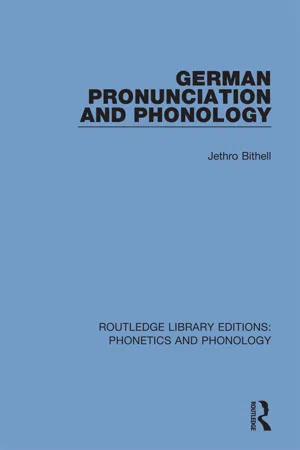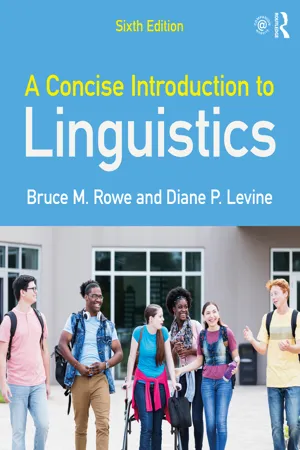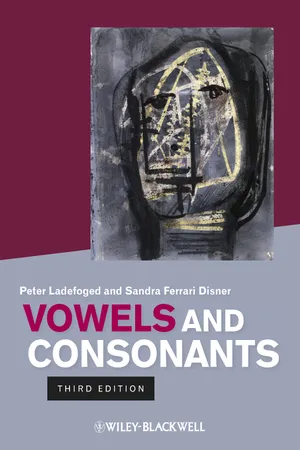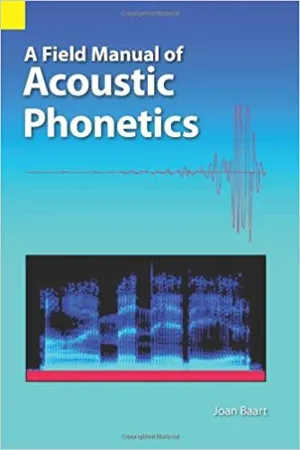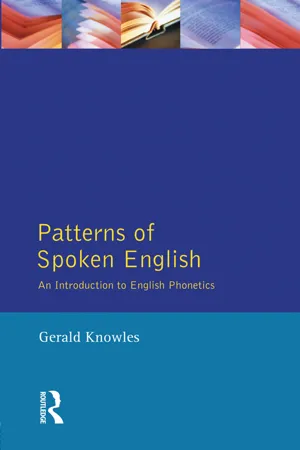Languages & Linguistics
Voiceless
"Voiceless" refers to a speech sound produced without vibration of the vocal cords. In phonetics, voiceless sounds are characterized by the absence of vocal cord vibration during their production. These sounds are contrasted with their voiced counterparts, which involve vibration of the vocal cords. In English, examples of voiceless sounds include the sounds /p/, /t/, and /k/.
Written by Perlego with AI-assistance
9 Key excerpts on "Voiceless"
- eBook - ePub
- Jethro Bithell(Author)
- 2018(Publication Date)
- Routledge(Publisher)
Actually there are three phases of voice: (1) the vocal cords may vibrate during the whole period of articulation; the sound is then fully voiced. Or (2) they may vibrate during a part of the period of articulation—at the beginning, or in the middle, or at the end of the sound; it is then partially voiced. Or (3) the vocal cords may not vibrate at all; they may, however, not be in the position of breathing, but in an intermediate position between the position of breathing (Weitstellung) and the position for the production of voice; and it is when the vocal cords are in such an intermediate position that the sound is, properly speaking, devoiced. Voiceless and voiced are extreme stages, between which these intermediate stages of devoicing occur. Thus in French l is fully devoiced after a Voiceless consonant: peuple [pœp ], but only partially devoiced after a voiced consonant: table [tab ] and in the middle of a group of sounds: Alpes. (In French devoiced sounds are so acoustically weakened that they tend to disappear.) The safe rule for German is that when a voiced sound is adjacent to a Voiceless sound the voiced sound tends to adjust itself to the Voiceless sound; and if the Voiceless sound precedes the voiced sound then the beginning of the voiced sound is devoiced, while if the Voiceless sound follows the voiced sound then the end of the voiced S EMI -C ONSONANTS [blu tə], and in foreign words before accented -on and in unaccented -ie : Nation [na si l o n], Familie [fa mi lĭ ə]. [ü] occurs in foreign words such as Statue [ l ? ta tu? ə]. The semi-consonants are sub-members respectively of the phonemes [j] and [w], and they are intermediary between these consonants and the vowels [i] and [u]. The difference between consonant and semi-consonant is that their frictional quality varies; in North Germany they are articulated with more friction than in South Germany - eBook - ePub
- Bruce M. Rowe, Diane P. Levine(Authors)
- 2022(Publication Date)
- Routledge(Publisher)
Table 2.1 lists voiced and Voiceless sounds in English.All sounds can be classified as either voiced or Voiceless. Some sounds differ only in this one characteristic. For instance, [z] and [s] are produced in the same way and at the same location in the mouth, the only difference being that [z] is voiced and [s] is not.Consonants and vowels
An airstream, usually from the lungs, supplies the energy for speech. The degree of openness of the vocal folds sets up an alternation between oscillating and nonoscillating pulses of air. Yet this is not speech. The airstream must be altered in still other ways before speech will be intelligible. Speech sounds are divided into two major classes, consonants and vowels.Consonants
A consonant is produced when the pulses from the larynx, either voiced or Voiceless, are impeded by a part of the vocal tract. The airstream can be immediately blocked by the momentary closure of the glottis (the gap between the vocal folds) followed by a sudden opening. Such a sound is called a glottal stop, for the location of the interruption of the airstream (the glottis) and the manner in which the stream is interrupted (momentarily stopped). When you cough, even though a cough is not a speech sound, you are creating this type of sound. When you respond with surprise by saying what might be represented in spelling as uh-oh, you are also making this kind of sound. In both cases, you should be able to sense the vocal folds being pressed together.A consonant is a speech sound that is produced when the airstream is constricted or stopped (and then released) at some place along its path before it escapes from the body.The glottis is at one end of the vocal tract above the larynx. The lips are at the other end. In the initial sound of pat, the lips touch each other in a momentary obstruction of the airstream. This type of obstruction is called a bilabial stop - eBook - ePub
Hearing
An Introduction to Psychological and Physiological Acoustics, Sixth Edition
- Stanley A. Gelfand(Author)
- 2017(Publication Date)
- CRC Press(Publisher)
allophones in that language because replacing one for the other does not change the meaning of words. Implicit in the distinction of phonetic and phonemic elements is that even elementary speech sound classes are to some extent learned. All babies the world over produce the same wide range of sounds phonetically; it is through a process of learning that these phonetic elements become classified and grouped into families of phonemes that are used in the language of the community.Speech Sounds: Production and PerceptionOur discussion of speech sounds will be facilitated by reference to the simplified schematic diagram of the vocal tract in Figure 14.1 . The power source is the air in the lungs, which is directed up and out under the control of the respiratory musculature. Voiced sounds are produced when the vocal folds (vocal cords) are vibrated. The result of this vibration is a periodic complex waveform made up of a fundamental frequency on the order of 100 Hz in males and 200 Hz in females, with as many as 40 harmonics of the fundamental represented in the waveform (Flanagan, 1958) (Figure 14.2a ). Voiceless (unvoiced) sounds are produced by opening the airway between the vocal folds so that they do not vibrate. Voiceless sounds are aperiodic and noise-like, being produced by turbulences due to partial or complete obstruction of the vocal tract. Regardless of the source, the sound is then modified by the resonance characteristics of the vocal tract. In other words, the vocal tract constitutes a group of filters that are added together, and whose effect is to shape the spectrum of the waveform from the larynx. The resonance characteristics of the vocal tract (Figure 14.2b ) are thus reflected in the speech spectrum (Figure 14.2c ). The vocal tract resonances are called formants , and are generally labeled starting from the lowest as the first formant (F1), second formant (F2), third formant (F3), and so on. This is the essence of the source-filter theory , or the acoustic theory of speech production ( - eBook - ePub
Linguistics for Language Teachers
Lessons for Classroom Practice
- Sunny Park-Johnson, Sarah J. Shin(Authors)
- 2020(Publication Date)
- Routledge(Publisher)
A phonetic alphabet solves these problems by representing each sound in human speech with a single symbol. Using a phonetic alphabet enables us to transcribe spoken language consistently and accurately. In this book, we will use the International Phonetic Alphabet (IPA), found in the inside back cover of this book (IPA Chart, 2015). The IPA is applicable to all spoken human languages and can be used to describe the sounds of any language. The symbols in the IPA are enclosed in slashes / / or brackets [ ] to indicate that the transcription is phonetic. The IPA does not represent the spelling system of any particular language.2.3 Articulatory Phonetics: How Sounds Are Produced
Most speech sounds are made by pushing air out of the lungs. Try talking while breathing in and you will notice it’s much more difficult than talking while breathing out. Air from the lungs goes up the trachea (also known as the windpipe) and into the larynx, where it passes through the space between the vocal cords, called the glottis. After the air passes through the glottis, it goes through the tube in the throat called the pharynx. Then the air goes out of the oral cavity through the mouth, or out of the nasal cavity through the nose. Sounds made when the vocal cords are vibrating are called voiced, while those made when the vocal cords are apart are called Voiceless. To hear the difference between a voiced and a Voiceless sound, put your fingertips lightly on your throat and say a long s sound (like a snake). You should feel no vibration as the vocal cords are separated to make this Voiceless sound. Now with your fingertips still on your throat, say a long z sound. You will feel a vibration of the vocal cords for this voiced sound.The difference in voiced and Voiceless sounds is important for distinguishing sounds. Table 2.1 - eBook - ePub
- Peter Ladefoged, Sandra Ferrari Disner(Authors)
- 2012(Publication Date)
- Wiley-Blackwell(Publisher)
Figure 13.1 as seen from the opposite direction. The back of the cricoid cartilage (which you cannot feel) is much thicker than the part you can feel in the front. There are two important cartilages resting on it, the arytenoid cartilages. The vocal folds are thin, multilayered folds of tissue with a muscular core, which are attached to the arytenoid cartilages at the back (posteriorly, as the anatomists would say) and to the thyroid cartilages in the front (anteriorly). The arytenoid cartilages are controlled by a complex muscle system that allows them to be rotated and to slide along the cricoid cartilage. When they are rotated they pull the vocal folds apart, forming Voiceless sounds. They can also be used to adjust the positions of the vocal folds so that various voice qualities are produced, as we will see in this chapter.Figure 13.2 Larynx viewed from behind (drawing by Siri Tuttle).13.2 Voiced and Voiceless SoundsIn Chapter 6 we saw that vocal fold actions distinguish Voiceless sounds such as f and s in fat and seal from their voiced counterparts v and z in vat and zeal . Most languages have some sounds that differ only in that one is voiced and the other is Voiceless (although, as we will see later, Hawaiian does not). Many languages have more pairs of sounds than those found in English. Burmese has Voiceless versions of lateral sounds, and of nasal sounds as shown in Table 13.1 and Recording 13.1 , that occur only as voiced sounds in English. Voiceless versions of voiced sounds are indicated by a small open circle under or over the voiced symbol, The accents above the Burmese vowels indicate the tones, which affect the meanings of the words, just as the tones affect the meanings of the Chinese words discussed in Chapter 2.Table 13.1 Words illustrating contrasts in voicing and aspiration in BurmesePlease refer to www.wiley.com/go/ladefoged for the recording.Welsh is another language that has Voiceless versions of sounds that are always voiced in English. The Welsh spelling ‘ll’ indicates a Voiceless alveolar lateral, which is usually fricative and has the IPA symbol ɬ . It appears at the beginning of the word ɬan , llan ‘church’, and in the name of the Welsh captain in Shakespeare’s Henry V , ɬuɛlɪn Llwelyn .13.3 Voicing and AspirationThe sound of English b is not quite the same as Spanish b. English p is also not the same as Spanish p. Table 13.2 shows some words illustrating these sounds. The first syllables of each of these words are similar in the two languages, but if you listen to Recording 13.2 you will hear that there is a difference between them. Spanish pe(sos) sounds more like English ba(sis) than English pa(ces) - eBook - ePub
- Joan L. G. Baart(Author)
- 2018(Publication Date)
- SIL International(Publisher)
Dutch is one of many languages that have a contrastive distinction between voiced and Voiceless plosives. Figure 4.4 shows an example of [d] and [t] contrasting in identical environments. The terms voiced and Voiceless suggest that the primary phonetic distinction between these two consonants is the presence versus absence of vocal fold vibration. However, an acoustic study of the contrast shows that there are other phonetic differences as well, and that vocal fold vibration may actually not be the most consistent cue to voicing.Figure 4.4. Speech wave graphs of Dutch Katootje (a girl’s name) and kadootje ‘a present’, showing Voiceless [t] (upper panel) and voiced [d] in identical environments; vertical lines mark off the closure phase of both consonants.It is clear in the given example that the closure phase of the voiced plosive (lower panel) is filled with a low-intensity periodic sound signal, which is due to the continuing vibration of the vocal folds. During the closure of the Voiceless plosive (upper panel), on the other hand, no signal is seen at all. Indeed, presence versus absence of vocal fold vibration is associated with the voiced-Voiceless distinction in this example.At the same time, another acoustic difference is easily noticed in the figure: the closure phase of the [t] is much longer (151 ms in this example) than that of the [d] (97 ms). In fact, the duration of the Voiceless plosive as a whole is quite a bit longer than the duration of the voiced plosive.It is also true in this example that the vowel preceding the Voiceless plosive is shorter (159 ms) than the vowel preceding the voiced plosive (166 ms). These durational patterns have been observed for many languages: Voiceless plosives are longer in duration than voiced plosives, while vowels preceding Voiceless plosives are shorter than vowels preceding voiced plosives (assuming that we compare identical vowels in environments that are identical—apart from the voicing distinction between the plosives). The duration of the preceding vowel, one can say, tends to compensate for the duration of the plosive. - eBook - ePub
- Ali Almanna, Juliane House(Authors)
- 2023(Publication Date)
- Routledge(Publisher)
‘bark’ in a similar way. Which sound is missing in your language?Note that nasals (/m, n, ŋ/), glides (/w, j/), and liquids (/r, l/) are all voiced. To explain how we can distinguish between voiced and Voiceless sounds, try to place your finger(s) on the voice box (i.e. the location of the Adam’s apple in the upper throat) and say (1) ssssssssssssssss and then (2) zzzzzzzzzzzzzzzz. What do you feel? Is there any vibration? If yes, then the sound is a voiced sound; otherwise, it is a Voiceless sound. To put it differently, at the phonation stage, to produce a voiced sound such as /z/, the vocal folds are brought together fairly tightly. However, to produce a Voiceless sound like /s/, the air passes through the glottis as the vocal folds are set apart.How many vowels are there in your own language?Vowels
Unlike consonants, vowels “are produced in a smaller area of the vocal tract – the palatal and velar regions” (Davenport and Hannahs 2010 : 39). To produce vowels, people use their tongue, lips, and jaw. As such, in describing and classifying the vowels, full consideration is given to these three speech organs. It is worth noting that the most difficult task in describing the vowels is to identify the position of the tongue as it changes its position from one vowel to another without touching any place of articulation (such as teeth, alveolar ridge, palate, velum, or glottis) discussed in the previous section. With this in mind, in producing vowels, there will be no obstruction to the air flow through the mouth. However, the position of the lips and jaw will not cause a big problem as it can be identified by the person without the aid of any instrument.To begin with, let us try to pronounce these two vowels:- /iː/ in ‘see’
- /ɒ/ in ‘watch’
- eBook - ePub
Patterns of Spoken English
An Introduction to English Phonetics
- Gerald Knowles(Author)
- 2014(Publication Date)
- Routledge(Publisher)
Stops can also be voiced, but in this case the voiced/Voiceless distinction is more difficult to perceive. In order to get the vibrations going, air has to pass through the larynx; but if the air stream is blocked somewhere in the mouth, it follows that not much air will get through the larynx. The main difference between voiced and Voiceless stops is not in the sound produced while the stop is being held, but in the influence of the stop on neighbouring sounds.Exercise Each of the following sounds is Voiceless. What is the corresponding voiced sound?k ʃ p θ f s tTranscribe the following words, and identify each phoneme as voice as Voiceless:pan crack bend toffee shortsSay the words carefully to yourself: identify the points at which the voicing is switched on and off.Approximant typesIn order to describe the more open types of articulation, we need to combine two ideas which we have already discussed. First, the wider the air channel, the less efficient it is at generating noise: the more open types of articulation consequently tend to be voiced. Secondly, the effect of voicing is to reduce the flow of air, and this in turn reduces further the amount of noise produced. For instance, if we make a /r/ sound, it is voiced, and there is too little air flow to produce any turbulence. Now if we were for some reason to make the /r/ Voiceless, that would increase the breath flow: if the organs remain at the same distance apart, the increased flow might now be sufficient to generate turbulence. In fact, English /r/ is sometimes Voiceless and turbulent; this happens when it follows /p, t, k/ at the beginning of a syllable, as in priest, crow, train . If you say these words slowly to yourself- or better still, get someone who knows nothing about phonetics to say them for you – you may be able to detect this Voiceless /r/. It will probably be easiest to hear in train . On the other hand, no matter how much you increase the breath flow when you make an /a/ sound, you are very unlikely to produce any turbulence in the mouth: indeed, you will almost certainly produce a bronchial wheeze first!We can use these properties to subdivide the category of sounds made with resonance. We shall use the term APPROXIMANT for sounds where the articulators are close enough to generate turbulence when there is a high breath flow, and reserve the term RESONANT for sounds which are never noisy. There is no absolute cut-off point where ‘approximant’ gives way to ‘resonant’; rather there is a scale with the organs fairly close together at one end, and the mouth wide open at the other. We shall simply call this the scale from ‘close’ to ‘open’. - eBook - ePub
Introducing Language in Use
A Course Book
- Andrew John Merrison, Aileen Bloomer, Patrick Griffiths, Christopher J. Hall(Authors)
- 2013(Publication Date)
- Routledge(Publisher)
Chapter 10 . The production of fricatives is the easiest to understand, so that is where we’ll start.9.3.1 Voiceless fricatives
When you lightly purse your lips and send out a directed draught of air to blow dust off the screen of a mobile phone, you make a sound [ɸ ] that is used in some languages, for example as the first consonant in the name of Japan’s iconic mountain: [ɸ u̜ dʑ isaɴ ], Fuji-san , i.e. Mt Fuji. Do a little puff of this kind at some imaginary dust on a mirror. You should be able to see in the mirror that the air is coming out of a narrow parting between your lips, maybe 15 mm from side to side and with a height in the centre, below the tip of your nose, of only about 2 mm. The noise of [ɸ ] is created just in front of your mouth by the air rushing out of that narrow channel and tumbling into air molecules that were occupying the space between your lips and the mirror. The noise of air molecules turbulently brushing against other air molecules and squeezing through gaps between them is ‘friction’ noise, and speech sounds with friction noise are called fricatives. The fricative [ɸ ] is made at the exit from a channel created with both lips, so it is a BILABIAL FRICATIVE . Furthermore [ɸ ] is a Voiceless sound (and what that means will be explained in a later section of this chapter), so a full phonetic label for [ɸ ] is Voiceless BILABIAL FRICATIVE . All the sounds focused on in the rest of this chapter are Voiceless ones.Check two points: (1) that friction noise cannot be generated with a channel that is too wide and (2) that when you are making [ɸ ] air is not simultaneously escaping through your nostrils. Perform the first check in front of a mirror by setting your lips at the opening they would have for the vowel schwa [ə ], which you might have for the first syllable in the English word ahead or the vowel sound at the end of the word sofa . This involves lips spread to have a gap about 5 cm from left to right and a height of around 15 mm in the centre. (To estimate this you’ll need to hold a ruler near your lips and be able to read mirror images of numbers!) Keeping the lips with that size of opening can you usefully blow dust off things a hand’s length away from your lips? We can’t and there’s no audible friction noise from the vicinity of our lips. Conclusion, a narrow constriction is essential for making fricatives. The technical term in phonetics for an articulation that interferes with the flow through of air in the vocal tract is stricture, and that term will be used from now on. The complete closure made for a stop, such as the bilabial closure for [p] or [m], obviously interferes with the flow of air, so complete closure is one kind of stricture. In the case of fricatives, two parts of our speech apparatus come close enough together to make noisy turbulence, but not close enough to shut off a passage entirely. In phonetics the full label for such a stricture is CLOSE APPROXIMATION
Index pages curate the most relevant extracts from our library of academic textbooks. They’ve been created using an in-house natural language model (NLM), each adding context and meaning to key research topics.
Explore more topic indexes
Explore more topic indexes
1 of 6
Explore more topic indexes
1 of 4
